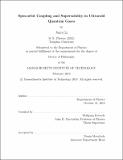Spin-orbit coupling and supersolidity in ultracold quantum gases
Author(s)
Li, Junru,Ph. D.Massachusetts Institute of Technology.
Download1132797177-MIT.pdf (56.39Mb)
Other Contributors
Massachusetts Institute of Technology. Department of Physics.
Advisor
Wolfgang Ketterle.
Terms of use
Metadata
Show full item recordAbstract
Ultracold quantum gases provide a clean, isolated, and controllable platform for simulating and characterizing complex physical phenomena. In this thesis, I present several experiments on realizing one-dimensional spin-orbit coupling in ultracold 23Na gases and the creation of a new form of matter with supersolid properties using interacting spin-orbit coupled Bose-Einstein condensates. The first part describes the realization of spin-orbit coupling in optical superlattices which consist of stack of pancakes of imbalanced double-wells. The orbital levels, individual pancakes, in an superlattice potential are used as pseudospin states. Spinorbit coupling was induced by two-photon Raman transition between the pseudospin states, and was experimentally characterized by the spin-dependent momentum structure from this dressing. The realization suppresses heating due to spontaneous emission. The system is highly miscible, allowing the study of novel phases in interacting spin-orbit coupled systems. Next, spin-orbit coupling was demonstrated by synchronizing a fast periodically modulating magnetic force with the Radio-Frequency (RF) pulses. The modulation effectively dressed the RF photons with tunable momentum. The consequent Doppler shifts for RF transitions were observed as velocity-selective spin flips. The scheme is equivalent to Floquet engineered one-dimensional spin-orbit coupling. Finally, I report experiments on creating a new form of matter, a supersolid, in ultracold quantum gases. An interacting spin-orbit coupled Bose-Einstein condensate in the stripe phase spontaneously breaks two continuous symmetries : the U(1) symmetry, observed as sharp interference peaks in momentum space, and the continuous translational symmetry, observed as a spontaneously formed density modulation. The density modulation is measured and characterized with Bragg scattering. A system spontaneously breaking these two symmetries is a crystal and a superfluid simultaneously, and is considered as a supersolid.
Description
This electronic version was submitted by the student author. The certified thesis is available in the Institute Archives and Special Collections. Thesis: Ph. D., Massachusetts Institute of Technology, Department of Physics, 2019 Cataloged from student-submitted PDF version of thesis. Includes bibliographical references (pages 207-214).
Date issued
2019Department
Massachusetts Institute of Technology. Department of PhysicsPublisher
Massachusetts Institute of Technology
Keywords
Physics.